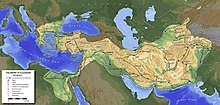Expeditionary warfare
This article needs additional citations for verification. (February 2024) |
| Part of a series on |
| War |
|---|
 |
Expeditionary warfare is a military
In the ancient world

The earliest examples of expeditionary warfare come from the

The raiding tactics were expanded into the more complex expeditionary warfare operations by Alexander the Great who used naval vessels for both troop transporting and logistics in his campaigns against the Persian Empire.
The next exponents of expeditionary warfare in the ancient world of the Mediterranean Basin were the Carthaginians who introduced two entirely new dimensions to the use of naval forces by staging not only operations that combined naval and land troops, but also eventuated in combining strategic multi-national forces during the land phase of the operation when Hannibal in his most famous achievement at the outbreak of the Second Punic War marched an army, which included war elephants, from Iberia over the Pyrenees and the Alps into Northern Italy.
Following on the example of Carthage, the Romans used expeditionary operations extensively to expand their Empire and influence in the Mediterranean and beyond, including the Roman conquest of Britain which was not only a limited expeditionary operation, but one conceived to include long-term occupation and Roman settlement of the territories.

The Han dynasty of ancient China also famously used expeditionary warfare to deal with the nomadic Xiongnu people during the Han–Xiongnu War. Under the orders of Emperor Wu of Han, the Han launched numerous long-distance raids deep into Xiongnu territory. The exploits of famed Han generals Wei Qing and Huo Qubing were of particular note, with both recording multiple successful expeditions between the years 127 and 119 BC, eventually annexing the Hexi Corridor and expelling the Xiongnu from the Qilian Mountains. The expeditionary Han forces were primarily made up of cavalry and were typically arrayed in columns. They also frequently crossed vast distances–Huo Qubing is said to have travelled 2,000 li, roughly 620 miles, during one of his raids.
In the Middle Ages
Shortly after the collapse of the Roman empire in Italy, the European Middle Ages began with an expedition of imperial Byzantine general Belisarius against the Vandals. But as that empire dwindled, its warfare became more defensive.
The most prominent development of expeditionary warfare during the Middle Ages came from the environmental pressures in the Scandinavian region during the Middle Ages, and the emergence of the Viking migrations that combined raiding, longer term inland operations, occupation and settlement. These operations were conducted as sea, coastal and riverine operations, and sometimes were strategic in nature, reaching as far as Constantinople.
Expeditionary warfare in East Asia began very much in the same way it had in the Mediterranean with short-term raids by Japanese pirates. Because the wokou were weakly resisted by the Ming dynasty, the raiding eventually developed into fully-fledged expeditionary warfare with the Japanese invasions of Korea (1592–1598).
During the Crusades
The development in expeditionary operations reached a new level when during the
The rise of European colonial empires

Although all expeditionary warfare until the invention of the combustion engine was largely dependent on sailing vessels, it was with the creation of sophisticated rigging systems of the European Renaissance that the Age of Sail allowed a significant expansion in expeditionary warfare, notably by the European colonial empires. Some have argued that this was the first revolution in military affairs that changed national strategies, operational methods, and tactics both at sea and on the land. One notable example of this evolution was the French invasion of Egypt (1798).
Though a significantly expanded expeditionary operation, the Crimean War was the first example of a planned expeditionary campaign that was directed as part of a multinational coalition strategy. It was also the first modern expeditionary operation that used steam-powered warships and telegraph communications.
The next development in the evolution of the expeditionary warfare was made during the expansion of the western
The World Wars
First World War
The period of the

Other expeditionary forces during WWI included:
- Canadian Expeditionary Force 1914–1920
- First Australian Imperial Force (Europe)
- Indian Expeditionary Force1914–1918
- Hejaz Expeditionary Force (Ottoman Empire) 1916-1919
- South African Overseas Expeditionary Force 1915–1919
- New Zealand Expeditionary Force 1914–1918
- Portuguese Expeditionary Corps 1917–1918
Second World War


- Afrika Korps (Nazi Germany)
- Corpo Aereo Italiano (Fascist Italy)
- Corpo Truppe Volontarie
- Brazilian Expeditionary Force
- British Expeditionary Force
- Canadian Corps
- China Expeditionary Army (Imperial Japan)
- Chinese Expeditionary Force (Chinese Army)
- Italian Expeditionary Corps in Russia
- Second Australian Imperial Force
Contemporary
European Union
NATO
United Kingdom

- 3rd Division (United Kingdom)
- 16 Air Assault Brigade
- 3 Commando Brigade
- Joint Expeditionary Force (Maritime)
- Joint Expeditionary Force
- Combined Joint Expeditionary Force
- Joint Rapid Reaction Force
- No. 83 Expeditionary Air Group
- No. 901 Expeditionary Air Wing
- No. 902 Expeditionary Air Wing
- No. 903 Expeditionary Air Wing
- No. 904 Expeditionary Air Wing
- No. 906 Expeditionary Air Wing
- Expeditionary Air Wing
- No. 34 Expeditionary Air Wing
- No. 38 Expeditionary Air Wing
- No. 121 Expeditionary Air Wing
- No. 135 Expeditionary Air Wing
- No. 138 Expeditionary Air Wing
- No. 140 Expeditionary Air Wing
United States

- Carrier Strike Group

- Navy Expeditionary Combat Command
- Expeditionary Strike Group
- Marine Expeditionary Force
- Marine Expeditionary Brigade
- 1st Marine Expeditionary Brigade
- 2nd Marine Expeditionary Brigade
- 3rd Marine Expeditionary Brigade
- Marine Expeditionary Unit
- List of Air Expeditionary units of the United States Air Force (43 of them)
See also
- Blue-water navy
- Expeditionary energy economics
- Expeditionary maneuver warfare
- Loss of Strength Gradient
- Military deployment
- Military logistics
- Over-the-beach capability
- Power projection
- Seabasing
- Unsinkable aircraft carrier
References
External links
- Response Force Task Group (RFTG) (Royal Navy PDF)
